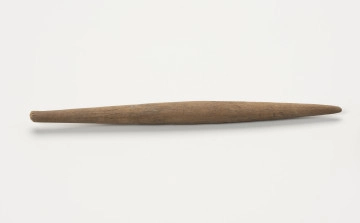
Spindle whorl
900 — 1100
National Museum in Szczecin
Part of the collection: Middle Ages
Making thread from fibres, or spinning, is very time-consuming and labour-intensive, even though it consists of only three basic operations. The first one is drawing out a strand of thread from a bundle of fibres, the second is twisting, which brings the fibres together tightly, and the third is winding them into a ball on a spindle or bobbin. Spinning can also be done without any accessories. Twisting with one hand on the thigh or between the palm and cheek does not require any accessories. In these cases, the resulting yarn is uneven, and each of the three basic operations was performed separately, further lengthening the process. Spinning is greatly facilitated using simple utensils such as a hooked twig, a rod or even a bird's feather. In the early Middle Ages, it was common to use a spindle on which the yarn and spinner were wound; it prevented the finished thread from slipping and facilitated the spindle's whirling motion, thanks to which the wound thread was even. Thanks to archaeological research in Pomerania, we know clay spinning rods and those made of rock, from the so-called soft rocks, including sandstone. As a rule, stone spinners are flat, of various heights, sometimes decorated with simple fluted patterns, as in the case of the specimen from Jarszewo.
Anna Bogumiła Kowalska
Author / creator
Dimensions
cały obiekt: height: 4.5 cm, width: 4.3 cm, diameter: 4.4 cm
Object type
spindle whorl
Technique
grinding, drilling, rolling (chip processing)
Material
stone
Origin / acquisition method
field research
Creation time / dating
Creation / finding place
Owner
Muzeum Narodowe w Szczecinie
Identification number
Location / status

900 — 1100
National Museum in Szczecin

nieznany
951 — 1200
National Museum in Szczecin

nieznany
701 — 1100
National Museum in Szczecin
DISCOVER this TOPIC
Museum of King Jan III's Palace at Wilanów
DISCOVER this PATH
Educational path
0/500

We use cookies to make it easier for you to use our website and for statistical purposes. You can manage cookies by changing the settings of your web browser. More information in the Privacy Policy.
We use cookies to make it easier for you to use our website and for statistical purposes. You can manage cookies by changing the settings of your web browser. More information in the Privacy Policy.
Manage cookies:
This type of cookies is necessary for the website to function. You can change your browser settings to block them, but then the website will not work properly.
WYMAGANE
They are used to measure user engagement and generate statistics about the website to better understand how it is used. If you block this type of cookies, we will not be able to collect information about the use of the website and we will not be able to monitor its performance.